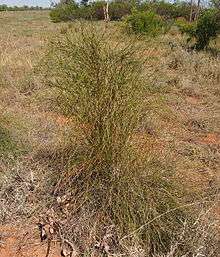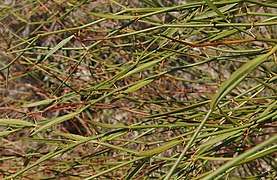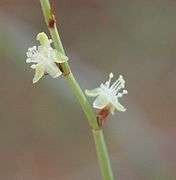Duma florulenta
Duma florulenta (synonym Muehlenbeckia florulenta), commonly known as tangled lignum or often simply lignum, is a plant native to inland Australia. It is associated with wetland habitats, especially those in arid and semiarid regions subject to cycles of intermittent flooding and drying out. The Wiradjuri name for the plant is gweeargal.[2]
| Tangled lignum | |
|---|---|
 | |
| Scientific classification | |
| Kingdom: | Plantae |
| Clade: | Tracheophytes |
| Clade: | Angiosperms |
| Clade: | Eudicots |
| Order: | Caryophyllales |
| Family: | Polygonaceae |
| Genus: | Duma |
| Species: | D. florulenta |
| Binomial name | |
| Duma florulenta | |
| Synonyms[1] | |
| |
Description
Lignum is a perennial, monoecious shrub, growing to 2.5 m in height, with its multitude of thin, intertwined and tangled branches and branchlets forming dense thickets to the exclusion of other species. Its thin, narrow leaves are 15–70 mm long and 2–10 mm wide.[3] The grey-green stems often end in a sharp point. The flowers are small and cream to yellowish, solitary or clustered along the branchlets and occurring through most of the year. The fruit is top-shaped, dry, and about 5 mm long.[4]
 Foliage
Foliage Flowers
Flowers
Lignum often appears leafless as the leaves are produced on younger growth but soon die off, especially in dry conditions. New leaves and shoots are rapidly produced in response to rainfall or flooding.[2] The plant has a very deep root system, penetrating the soil to at least 3 m in depth. It is highly tolerant of salinity and drought and may be used as an indicator of dryland soil salinity.[4] Because of its densely tangled growth habit, it provides protected breeding habitat for native wildlife such as waterbirds, though it can also provide refuge for pest species such as feral pigs, foxes and rabbits.[2]
Taxonomy
The species was first described by Carl Meisner in 1856 as Muehlenbeckia florulenta.[5] Molecular phylogenetic studies showed that M. florulenta, along with some other species placed in the same genus, formed a distinct clade, separate from Muehlenbeckia, so a new genus, Duma, was erected, and this species transferred as Duma florulenta.[6][7]
Distribution and habitat
Lignum occurs in all of Australia’s mainland states, as well as the Northern Territory. The plant's preferred habitats include floodplains, swamps, gilgais and other intermittently flooded areas. In southern Australia it is often associated with stands of river red gum and black box.[4]
References
- "Duma florulenta (Meisn.) T.M.Schust". Plants of the World Online. Royal Botanic Gardens, Kew. Retrieved 2019-03-04.
- "Lignum" (PDF). Wetland Plants. Murrumbidgee Catchment Management Authority. Retrieved 2011-03-31.
- Wilson, K.L. "Muehlenbeckia florulenta Meisn". New South Wales Flora Online. PlantNET. Retrieved 2011-03-31.
- "Lignum". Victorian Resources Online. Department of Primary Industries, Victoria. 2010-10-19. Retrieved 2011-03-31.
- "Plant Name Details for Muehlenbeckia florulenta Meisn". The International Plant Names Index. Retrieved 2019-03-04.
- Schuster, T.M.; Wilson, K.L. & Kron, K.A. (2011), "Phylogenetic relationships of Muehlenbeckia, Fallopia and Reynoutria (Polygonaceae) investigated with chloroplast and nuclear sequence data", International Journal of Plant Sciences, 172: 1053–1066, doi:10.1086/661293
- Schuster, Tanja M.; Reveal, James L.; Bayly, Michael J. & Kron, Kathleen A. (2015), "An updated molecular phylogeny of Polygonoideae (Polygonaceae): Relationships of Oxygonum, Pteroxygonum, and Rumex, and a new circumscription of Koenigia", Taxon, 64 (6): 1188–1208, doi:10.12705/646.5